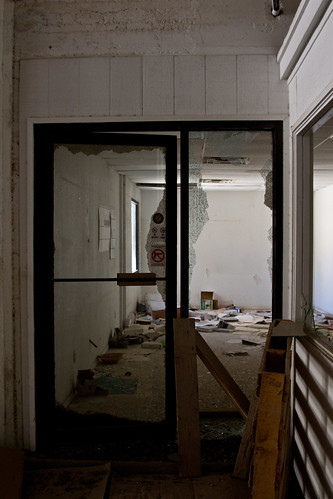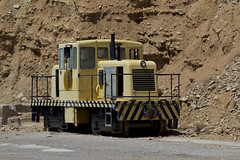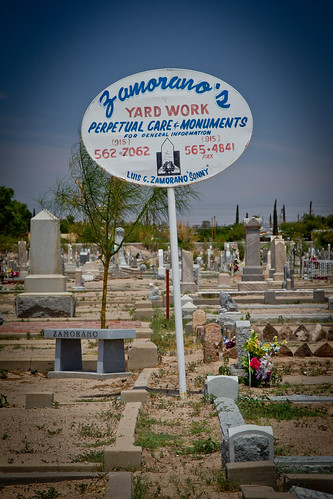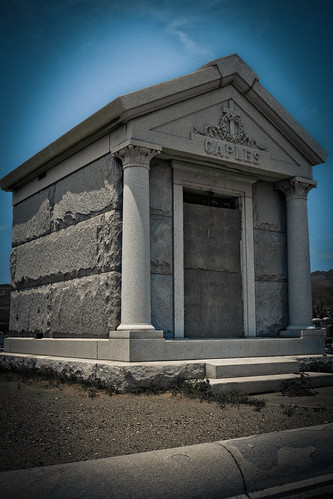Southwestern Portland Cement (Pt 5)
I stopped by for quick look around the outer perimeter:
View Southwestern Portland Cement in a larger map
The walk around the front silo takes you through a grassy area to a couple of buildings that are almost completely demolished. Little remains of the building closest to the railroad tracks.
The destruction in this area is more mechanical than from the ravages of time. Next to it is a larger building that has a large section opened up.
These two buildings were not safe to enter so I rounded around the front and back into complex interior to see if anything was different.
After passing under the offices I went back into the 3 story building, in the process spooking off four of the largest pigeons I have ever seen. I noticed something comical on the electrical panel that I hadn’t noticed before:
I had a flashlight with me this time but didn’t have the time to go into the offices. I want to get in there soon before it gets cold. I’ll have less of a chance of crossing somebody who might be using it as shelter.
Interesting side note, in the ongoing Asarco demolition, the smallest stack above was just demolished on Tuesday afternoon. The channel 9 news had video and made mention that the remaining two stacks are scheduled for demo in February.
Full Flickr set here: Southwestern Portland Cement 5
Plaza de los Lagartos
At the center of Jan Jacinto Plaza is a Luis Jiménez sculpture titled “Plaza de los Lagartos.” The piece pays homage to the parks unique history, once being the home to live alligators.
View San Jacinto Plaza in a larger map
The tale of the alligators is a sad one. Three were added to the park in the late 1800’s and were the main attraction for decades. Unfortunately they were frequently targeted by vandals until they had to be permanently removed from the park. Their last appearance in the park was in 1974.
The sculpture was part of a mid 90’s attempt to revitalize the downtown area. It originally was more kinetic, featuring water fountain and misting elements. Currently the fountain has been drained and the water features turned off. The ever present desert sun has faded the fiberglass sculpture quite a bit.
San Jacinto Plaza had served as the Sun Metro transportation hub for the Downtown area. This lead to an abundance of people waiting in the park for the bus as well as pan handlers and vagrants who slept in the grassy areas. To prevent that, the grassy areas were fenced off making the park not very park like.
Recently Sun Metro has moved the hub and now the park is rather empty. The revitalization bug has once again been caught by city council so to make the park more people friendly, the city has removed the fencing surrounding the grassy areas.
Surprising that little change really opens up the park. If I still worked downtown I would certainly eat my lunch here. More changes may be afoot though as a polarizing plan to revitalize the park even further has been drawn up by an outside design firm. One of the most prominent changes was the removal of the sculpture from the park altogether: San Jacinto Redesign
The alligators now have their own Facebook page (Los Lagartos) in protest to the redesign and others around the city have voiced concerns as well. I agree that a redesign should include some elements from the parks past. Jimenez’s sculpture could be refurbished and better incorporated into a water feature prominently drawing from the parks historical significance. If removal is still in the cards, then one would hope that any reuse of the sculpture doesn’t wind up being an affront to the original artist intent.
The city should follow the recent revitalizations of the Plaza Theater and the Mills building. Both have been brought into this century while maintaining their heritage. The Mills building even added back some nice architectural elliments that had been removed by the previous owners refurb in the 70’s:
That’s the one thing that El Paso really has going for it, architectural history. After being largely neglected but left intact, we are finally waking with the desire to improve our downtown. We should resist the attempts to go whole hog modern, we are never going to be “that city”. Lets move forward by better using what we have.
A larger flicker walk through is here: San Jacinto Plaza
Return to Southwestern Portland Cement
For a few months I’ve been exploring an abandoned industrial plant located at the corner of Executive and the Border Highway, the Southwestern Portland Cement Plant.
View Southwestern Portland Cement in a larger map
In this trip I concentrated on the back portion of the complex. There is a cluster of buildings that are interconnected and appear to be in better condition than the front sections of the plant:
The walls were painted and boxes of equipment were scattered around. One portion had the remains of an office complete with a 2006 calender on the wall.
This area was quite striking in comparison to the older portions. Sure, it was still a mess but it had some cool items of late 90’s vintage:
Continuing on through the warehouse to the outside, there was a small yard diesel parked out back.
As I began to make my way back into the warehouse, I heard a truck coming around the corner. Since I’m not sure if the owners would like me wandering around their abandoned factory, I darted behind a shed. The truck parked out of my view by the warehouse and soon I could hear somebody whistling a tune. I figured I wasn’t in much danger and continued to take pictures outside while the pied piper was inside. After a few minutes, he appeared in a doorway nearby. As he turned to me I greeted him, “Hi”. Startled, he let out an “Aye cabrón!”. Luckily he wasn’t security, just a Cemex worker.
We chatted for a bit and he told me that Cemex rents this portion of the plant for storage explaining the somewhat refurbished condition. Seeing that I was taking pictures, he asked if I was interested in buying the place. I told him “No” and he said that was good because it would take a lot of money to clean up the asbestos. I now had my answer to this plants demise.
I still have one area left I would like to visit, the old front office. I may try to get to it soon because I’m not sure how much longer ill have access through the front. The road has been recently torn up by the ever advancing El Paso Water Utilities purple pipe project:
The full Flickr set can be viewed here: Portland Cement (pt.4)
The previous Flickr sets can be viewed here:
Set Three 6/21/2011
Set Two 5/16/2011
Set One 5/10/2011
Concordia Cemetery
Few places in El Paso are steeped legend and lore like Concordia Cemetery.
Concordia is the final resting place for all manner of historical figures; generals, outlaws, and civic leaders scattered alongside commoners and unmarked graves. The most famous resident and who’s remains were at the center of a recent legal battle between the city and his surviving family is John Wesley Hardin.
The purported outlaw extraordinaire, has had all manner of tall tales told about him. He has been portrayed as a gambler, outlaw, lawyer and heavy drinker with the truth lying somewhere in between. Famed El Paso historian, Leon Metz, has a book about him that you can browse through at Google Books.
The cemetery is relatively well maintained now, watched over by the Concordia Heritage Association. Occasional vandalism is still a problem but Concordia is nowhere near the scary drug den that I recall being warned about in my youth. The graveyard is broken out into sections which makes for an interesting walk through on cultural burial customs. El Paso may not have its own “Chinatown” but we at least have a place to bury the Chinese.
All of the sections have a mix of grave markers from very ornate and opulent tombs to simple unmarked wooden crosses. You’ll even come across a nice advertisement:
I guess if you buy the plot you can do what ever with it. One thing that struck me, as I wandered around looking at the family names scattered around, was how connected to El Paso’s past many of these individuals are. Their names are left not only here but all over El Paso, on buildings and street signs, permanent markers to their commitment to the city’s growth from dusty outpost to sprawling metropolis.
If you happen to be walking around during the summer, bring some water. There is hardly any vegetation or shade and no water fountains so it gets quite toasty. Or you could just hop over to L&J for a drink:
I have a bigger walk through that you can view at Flickr here: Concordia Cemetery






















